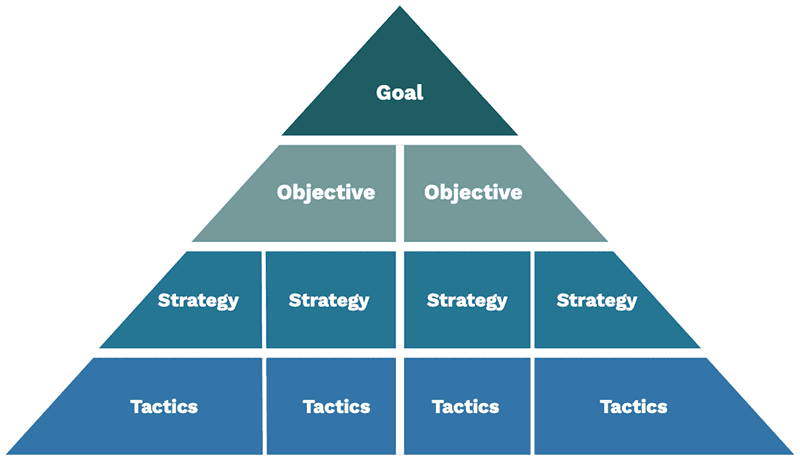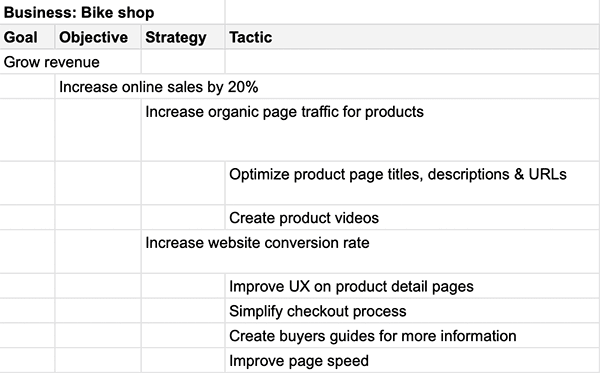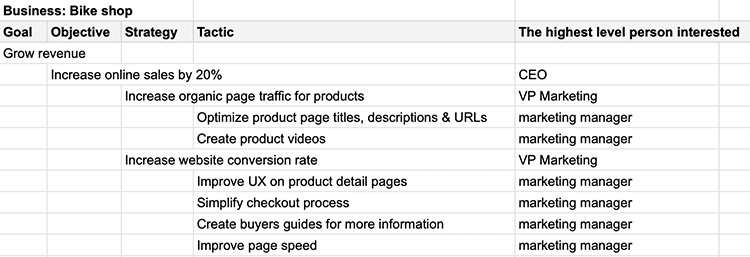Jane’s boss was zoning out again. It was bad enough that he questioned the relevancy of her meticulously collected MQL (marketing qualified leads) data while they were discussing the second page of her dashboard. The dashboard was beautiful, the culmination of months of work and an excellent distillation of the marketing team’s efforts. But now Jane was reviewing page four, and the boss was definitely not focused on what she was saying.
All too often, marketers and company leaders speak in different languages. Indeed, they have different ways of thinking about moving towards goals. And true, maybe marketers get lost in the weeds sometimes, while leaders need to stay focused on the big picture. It’s no surprise that marketers sometimes have trouble communicating to leadership in a way that connects and motivates them to stand behind marketing as an investment.
In this article, I’ll share with you an approach to bridging this gap. By taking a step back to think like business owners, marketers can show how marketing activities are tracking to business goals, and communicate our efforts and successes in a way that demonstrates the value marketing has for the business as a whole.
Thinking Like a Business Owner
One way to bridge the communication gap between marketers and business leaders starts with thinking more like a business leader yourself.
Let’s walk a mile in the CEO’s shoes.
- CEOs and business owners are responsible for keeping the big picture in their head.
- They’re thinking about the business with a long time horizon and about the core metrics of the business: revenue, costs, and profit.
- And they’re thinking about how to get there from here: what are the roadblocks and opportunities presenting themselves right now that need to be dealt with to stay on track?
The key for marketers to better communicate with business owners is to be able to speak to how their efforts tie to the big-picture concerns. Sure, you’re working on keeping the company’s social media presence fresh. But how does that relate to the company’s overall goals? That is a gap it can be hard to see your way through.
I’m going to show you a way to think about how your marketing activities are tracking to business goals, so that you can communicate your efforts and successes in a way that actually demonstrates the value marketing has for the business as a whole.
Goals, Objectives, Strategies, and Tactics

To bridge the gap between what you’re doing on a day-to-day basis and what the business’s big goals are, it’s helpful to break down what the company is trying to do into several steps. First, think through what your company’s overall goals are, what specific objectives have been set which will get you to those goals, what strategies marketing has developed to achieve the objectives, and what tactics you are employing to execute the strategies. Let’s start from the top and work our way down.
- Goals. Leadership drives the company forward by setting goals, which align everyone behind the same priorities for getting things done. What is your company trying to accomplish? What would your leadership team say? Maybe it is increasing revenue or market share, launching a new product, or expanding to a new location.
- Objectives. The specific targets the company is trying to achieve. For example, what revenue goal in what timeframe?
- Strategies. Of all the possible options for getting to the targets, which approaches are your company pursuing? To increase revenue, are you introducing new products, expanding into a new geographic region, or increasing sales staff? Strategy requires trade offs–the business has chosen to do some things, and not others.
- Tactics. What activities are being done to support the strategies.
This outline shows what this might look like for a hypothetical business.
You may not know all the answers to these questions; some businesses are better than others at articulating and communicating like this. But that’s okay–I bet you can figure some of them out. And then you can interview your boss, and your boss’s boss if need be, to fill in the details and course correct.
You might also be able to work up from tactics. Take what’s on your plate, and consider why: what value do those activities have for the business? Let’s say you’re programming the company’s social media channel. What business value does this drive? Is it helping move the brand position towards the business’s future? Or building awareness which supports in-store sales?
Don’t get hung up on whether something is an objective or a strategy or a tactic, or a sub-objective or a sub-strategy. The right level isn’t important. What’s important is that you’re starting to visualize a hierarchy: how things you do in marketing map up to the company’s goals. And of course, your company has objectives & strategies that don’t touch marketing. For these purposes, leave those priorities out.
As you start to fill this out, you’ll be able to see more clearly: your day-to-day job as a marketer is probably too in the weeds for the business owner. Remember, what the business owner cares about is marketing’s overarching goals and if you’re on the right track to achieving them.

The owner of this business is focused on making sure all the wheels are turning to get to a 20% increase in online sales. The marketing team is focused on how to improve the website to hit these goals. What the business owner wants to know is, are the strategies working towards hitting the goals? If not, what are you doing to correct course? They don’t need to know which product pages have optimized page titles–that’s minutiae that distracts from the big decisions.
Communicating the Value of Marketing
This change in focus narrows in on the stories that matter to company leaders. So what’s the best way to communicate regularly what marketing’s doing and the value it’s providing?
Metrics, Dashboards, and Storytelling
With objectives, strategies, and tactics outlined, you can start to think about what metrics you can use to demonstrate progress.

Great! Let’s just pull those metrics into a dashboard, email the dashboard to your boss, and you’d be done, right?
No. You’d be missing a key element to communicating the value of marketing: the storytelling. Metrics on a dashboard all by themselves don’t tell a story. They don’t help business leaders understand why you’re doing what you’re doing, what the overall importance of what you’re doing is, and how it helps contribute to moving the business forward. You need to work harder–but the goals-objective-strategies-tactics foundation is what you need to get there.
My recommended outline for a regular marketing up-level meeting goes like this:
- Goals and Objectives
- Restate the company goals and objectives as you understand them. Ask for any updates.
- Show measurements to date, like year-over-year revenue.
- Share any top-level metrics your leaders have specifically asked for.
- Strategies
- List each strategy marketing is involved with.
- Share how you’re measuring and what the metrics are, with a table, graph, or a single metric compared to a benchmark or previous period.
- Provide a narrative (written, for posterity!) on highlights of performance and anecdotes for success or areas for improvement.
- Ask for what you need to make this strategy succeed.
- Be proactive. If your strategy isn’t working, how will you change it?
- What’s Keeping Them Up at Night?
- Keeping up with your CEO is no small task. Make sure to check in on current priorities and challenges, so you can help out.
I can’t promise that your CEO will never be distracted again if you follow these steps – that goes with the territory. I can say that tying the work that you do to the company’s overall goals will go a long way towards earning their respect and trust. If they believe that you are working towards the goals they have set for the company, they are much less likely to second guess the decisions you make.




